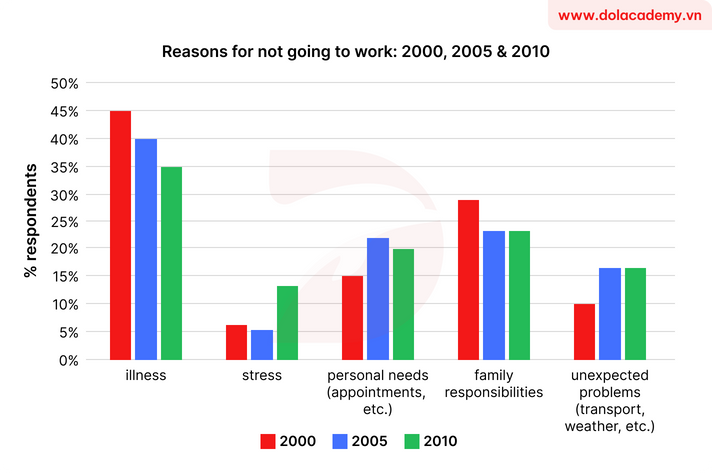Real IELTS Writing Task 1 - Bar Chart - Topic European Absenteeism & sample band 8.5+
[Quý 2/2024] Đề thi thật IELTS Writing Task 1 – Dạng Bar Chart, chủ đề European Absenteeism kèm bài mẫu band 8.5+, dàn ý chi tiết, từ vựng và bài tập ôn luyện.
🚀 Đề bài

😵 Dàn ý
DOL sẽ miêu tả biểu đồ với 1 câu mở bài (Intro), 1 đoạn miêu tả tổng quát (Overview), và 2 đoạn thân bài miêu tả chi tiết (Detailed Description)
Mở bài: DOL sẽ paraphrase đề bài để giới thiệu lại đề bài cho người chấm
Overview:
Tỷ lệ nghỉ làm do bệnh tật và trách nhiệm gia đình giảm dần, trong khi các lý do như căng thẳng, nhu cầu cá nhân và sự cố bất ngờ có xu hướng tăng lên.
Bệnh tật là nguyên nhân phổ biến nhất dẫn đến việc nghỉ làm, còn căng thẳng là lý do ít gặp nhất.
Thân bài:
Body 1: DOL sẽ mô tả số liệu về tỷ lệ các nguyên nhân gây nghỉ làm trong năm 2000.
Body 2: DOL sẽ mô tả số liệu về sự thay đổi của các nguyên nhân này từ năm 2000 đến 2010.
DOL sẽ tiếp tục phân tích dàn ý cụ thể bên dưới nhé.
- illness (45%)
- stress (6%)
- personal needs (15%)
- family resp (~30%)
- unexpected problems (10%)
- Illness = decrease (45 → 35)
- Stress = decrease (5) → increase (12)
- Personal needs = increase (22) → decrease (20)
- Family resp = decrease (23)& stable
- Unexpected = increase (17) & stable
📝 Bài mẫu
The bar chart presents the reasons for absenteeism in a European country in 2000, 2005, and 2010, across five categories: illness, stress, personal needs, family responsibilities, and unexpected problems.
Overall, both illness and family responsibilities
In 2000, illness
Between 2000 and 2010, the proportion
(181 words)
📚 Vocabulary
✨ Bài tập Exercise
Mình cùng làm 2 bài tập sau đây để ôn lại các từ vựng và cấu trúc đã được dùng trong bài IELTS Writing Sample Task 1 nhé!
Exercise 1: Điền từ / cụm từ phù hợp để hoàn thành câu sau.
1. Tỷ lệ đi trễ hàng tháng có xu hướng giảm kể từ khi áp dụng lịch trình linh hoạt.
-> Monthly tardiness incidents
2. Bệnh tật vẫn là lý do được nêu ra nhiều nhất khiến nhân viên nghỉ làm trong quý này.
-> Illness continues to
3. Các vấn đề bất ngờ là nguyên nhân luôn ít được nêu ra nhất gây ra tình trạng vắng mặt ở các phòng ban.
-> Unexpected problems are
4. Mệt mỏi và kiệt sức chiếm gần 30% tổng số trường hợp vắng mặt được ghi nhận.
-> Fatigue and burnout together
5. Căng thẳng liên quan đến công việc nổi lên là yếu tố chính dẫn đến việc nghỉ việc không có kế hoạch.
->
6. Theo khảo sát mới nhất, nhân viên thường viện lý do bệnh tật khi xin nghỉ ốm.
-> Employees frequently
Exercise 2: Tìm những từ / cụm từ tiếng Anh phù hợp với những từ / cụm từ sau.
vắng mặt do căng thẳng
nhu cầu cá nhân
giảm xuống còn
vấn đề bất ngờ
vẫn giữ nguyên
💡 Lời kết
Tới đây là hết rồi 😍 Sau sample “The chart below shows the results of three surveys on absenteeism in a particular European country in the years 2000, 2005 and 2010.", DOL mong các bạn không chỉ nắm được cách trả lời cho dạng bài Bar Chart, mà còn học được những từ vựng và cấu trúc hay để miêu tả các biểu đồ tương tự nhé.
Nếu có thời gian thì nhớ làm phần bài tập và tự mình viết một bài khác nha vì 'Practice makes perfect' mà nhỉ? DOL chúc các bạn học tốt! 🤩



